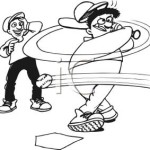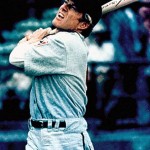If you would watch a professional baseball game (especially Major League) through the lens of a microscope you would notice that the effectiveness of all batters is determined by how well they wait for the right opportunity before they commit their bodies to begin forward motion to conduct their swings. Those who patiently wait for the precise moment to quickly and powerfully respond to the ball in the strike zone are most assuredly the more proficient of bats-men. But is there anything a batter can or must do while he is patiently waiting for the pitcher as he is delivering his pitch?
It is incumbent upon every batter to establish a rhythm in order to gain a sense of momentum to counteract the force of speed and power elicited by the throwing action of the pitcher’s body and arm before he can effectively initiate his swing. The most common prelude to any batter’s swing (professional or non-professional) is the usually-accepted “stride.” This stride can be utilized in a fashion either linear (straight-forward) or eliptical (front knee kick).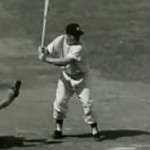
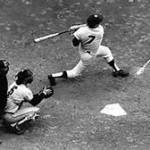
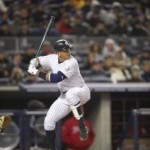
In the two photos of Mickey Mantle (above)it can be observed that he sometimes took a stride of about 2 feet, and was quite a notable bats-man who struck out a lot. Within the 50 or so years since Mantle and other former Baseball dignitaries graced the Major-League playing fields, new theories for greater batting prowess have evolved that would try to lessen the margins for error in swinging the bat, to diminish the strike out rate that the “long-stride” seemed to perpetuate.
The “high-leg kick” (like A-Rod, above) was an attempt at stabilizing the “head-from-moving” while still providing enough rythmic momentum to initiate the batter’s timing mechanism. The front foot would not stride out (as Mantle’s did) but simply relocate to the point from which it began. And, from there the action of swing could be initiated while the head and eyes remained relatively stable.
The swing itself cannot begin until the front foot has planted into the ground. And there have been many times when a batter’s foot was still in stride as the ball was in a position to be swung at. Or the foot was urgently planted a lot earlier than appropriate for swinging at the pitch. In either event the batter’s timing was adversely affected by the “stride,”from which he was too early or too late.
Also, the stride, whether linear or eliptical, moves the body, which moves the head which contains the eyes which would see the ball (as clearly as possible). The only solution from which to eliminate or diminish substantially the “margin for error” that depreciates a batter’s vision and timing effectiveness is the “No-Stride.” 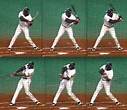
The proficient “bats-man” will remain balanced throughout the swing more often than the less proficient batter. And balance is determined by a consistent rotary flow of body parts, of which none preempts the timing and function of the others. If the batter is impatient (whether consciously or unconsciously), and starts his forward action too soon, the entire mechanism for balance is disturbed and the integrity of the swing is compromised. Once the flow begins it should not stop until “bat-ball” contact is made and the follow-through concluded. So the big question remains for each batter, “when to begin?”
Another question that accompanies the first is “what to begin?” To answer these two questions, in reverse order, is to discern the riddle and to solve the mystery of the phantom “.400-plus hitter.” The quandary involved in “what to begin?” is determined by whether, or not, the batter takes a “stride.” If he takes a stride, then his action begins with forward linear movement before he plants his front foot. If he doesn’t stride his first action is to plant (push down on) the front foot.
About 95% of all “Big-League” players stride toward the ball or the “plate”, and another 4.09% incorrectly interpret and apply the benignancy of the “non-stride”. Thus, less than 1% exhibit an understanding that the stride is an unessential element to initiate the proper swing. And the subtle answer to the query of why very few batters are inherent prospects to hit .400 or more in this generation is furthermore re-established!
Most hitters think they need the stride to initiate the momentum to counteract the power and velocity of the pitched ball, while the very act of striding is the determinant that will ultimately diminish the effectiveness of the function of an otherwise productive swing. The alternative (non-stride) is the correct approach, but no one seems able to put faith in its prospectus.
If a batter would “not-stride” he would eliminate the most detrimental margin of error in the complicated network of proficient “bats-man-ship”—seeing the ball with optimal acuity. Even if the distance and abruptness of the stride are negligible, keeping the head and eyes perfectly still is virtually impossible while the body is traversing any number of vertical planes. A single degree of movement would negate the level of efficiency to that same extent and nullify perfect acuity. If a batter could entertain the prospect of hitting .400, he would certainly have to reduce the margins of error with regard to all aspects of mental and physical procedures, of which optimal seeing is a top priority.
The problem that all batters face is their own reluctance to understand that the stride is not necessary for applying a forceful front foot plant just prior to the swing itself. It is merely a matter of mental and physical conditioning to attain the proper foot-plant to negotiate the swing. First, mentally recognizing the good prospect of the “non-stride,” then physically practicing the reaction-time sequence of maximum effort and movement ultimately will acclimate the batter to a higher proficiency level.
The “non-stride” entails a number of components that, if not considered equally important to each other, affect the integrity of the batting mechanism. But to understand the legitimacy of the non-stride is the first step in patiently conquering the .400 barrier.
Which of the following two questions best offers a solution to the problem of inefficient batting? Does the strength of the swing come from the stride, lunge of the body, and extension of the arms? Or does it come from the rapid and controlled rotary transfer of weight that occurs after the front foot plants and the front knee begins straightening diagonally to help force the front hip backwards, to allow the back hip to move quickly forward, with a turning bent back leg?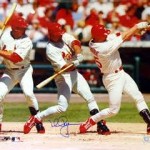
The actions, in the second question, lead the upper body into an orderly series of movements that precipitate a power surge directing the bat into the ball. And without a stride the batter can be assured of the best possible visual acuity for tracking the in-coming pitch.
The following conditioning sequence will facilitate a habit-forming regimen to accommodate the essential training needed to begin the conquest of stagnant hitting deficiency.
4-STEP HITTING DRILL: (This should be done without a bat first, then with a bat after total 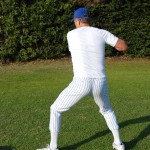
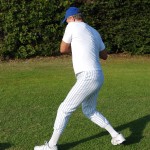
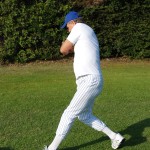
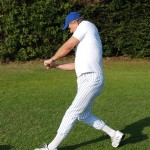
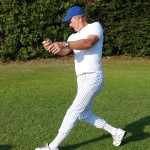 coordination has been mastered.)
coordination has been mastered.)
Step 1 – Assume a position of maximum strength and balance. Get as low a stance as to not feel too uncomfortable, with feet spread at the distance of your normal stride. (Remember, a low stance gives you a natural advantage of a smaller strike zone as well as a fundamental posture for stronger and quicker movement. If you understand the value of this “principle,” any physical discomfort you seem to have with a low stance will diminish as your body becomes acclimated through repetition and positive results.) Then begin the repetition of the entire hip-shoulder “weight-transfer,” step by step. Repeat five attempts focusing on the straightening of the front leg, by pushing down hard on the front foot with the feeling of pushing your body backward. If the body does actually fall backwards, off balance, your back foot and bent knee are not doing what are required of them.
Step 2– Focus on the action of the back leg. With a low stance, as you assume that the transfer of weight is imminent, drive the back bent-knee forward with force, rotating from the outside of the big toe of the back foot. Focus on maintaining a bent back leg during the simulation, but be conscious of the other three stages (especially the front leg).
Step 3—Focus on front shoulder action. As front foot is planting, be focused on how forcefully you can shrug and pull the front shoulder up and backward. If the movement feels weak, it’s probably because the hips did not initiate the action.
Step 4—Focus on back shoulder and elbow. When the front shoulder shrugs, the back shoulder (with elbow) automatically lowers. The muscles of the Pectoral (in chest) and Latissimus (in back) areas drive the elbow down and forward ahead of the back hand. The hand is thus in a palm-up position to force a flat bat through the ball. So focus on the backside of the upper body coming through. But be conscious that the front side seems to be initiating the action.
After these four steps have been mastered, use a bat and go through them again, using a batting tee until mastery is attained. After that, go through the same procedure, this time combining step one with step two, and step three with step four, making it a two-step drill. (Then, step two with step four, and step one with step three.)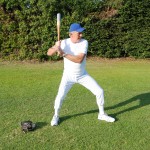
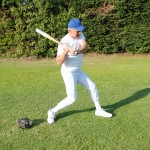
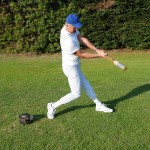
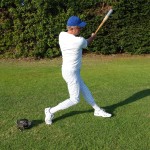
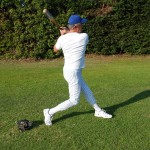
Remember, you are working to see how fast you can complete the entire action “perfectly.” Only perfect practice will make perfect, so perform the drills at full speed with the expectation of reacting faster as the mechanics of the swing are perfected. Eventually you can move the tee to cover all the areas of the strike zone. Remember also, to assure that the head not move, refrain from taking a stride—you really don’t need it anyway if you perfect the “four step” drill.
Also Remember: When assuming your stance, always have the front foot pointed at a 120 degree angle (or slightly less)to the pitcher, not a 90 degree angle (or more) which many batters assume because they have been told that it will keep their front hip and shoulder from opening too quickly. The front foot, at a 120 degree angle, will allow the weight tranfer during the swing to be more accommodating to the front knee, ankle, and foot joints. While, at 90 degrees or less, the tension on the front foot, ankle, and knee can have a dire affect on the ligaments and tendons while the body is twisting and turning on its rotating axes. Harold Baines and Ryan Howard can attribute their knee and ankle problems, and well as their erratic batting effeciency, to the extremely awkward front foot positioning in their stances. Just look at the front foot positioning of outstanding hitters such as Ted Williams and Joe DiMaggio, to validate the proper transfer of weight during the swing.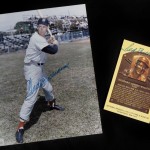
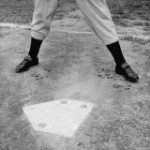
To “believe assuredly” is to have absolute faith in a proven principle. On the human level it’s hard to find an “Absolute” from which to have an absolute faith. The True consciousness in all of us can discern the correct path to take, the right doctrine to espouse, and the most plausibly scientific way to hit a baseball.
